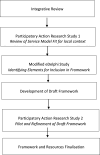Development of a framework for the collaborative adaptation of service models for child and family health in diverse settings (CASCADES)
- PMID: 36165065
- PMCID: PMC11141087
- DOI: 10.1177/13674935221129003
Development of a framework for the collaborative adaptation of service models for child and family health in diverse settings (CASCADES)
Abstract
The impact of health service access disparities has significant implications for society. The importance of addressing health and social inequities is never more critical than in the early years of a child's life. Despite advances in healthcare implementation, there is a lack of an evidence-based framework to specifically guide the adaptation of child and family health (CFH) service models for different community contexts. This paper describes the development of a framework for the adaptation of community-based CFH service models. Drawing on the findings of an integrative review and Delphi study, Participatory Action Research was used to test the framework, resulting in the Framework for Collaborative Adaptation of Service Models for Child and Family Health in Diverse Settings (CASCADES). The Framework uses the analogy of a waterfall to represent the iterative process of collecting information to inform each step. The framework supports a collaborative co-design approach to build a comprehensive understanding of the target community to inform the adaptation and evaluation of evidence-based interventions appropriate to the local context. The ultimate aim is to enable the delivery of services that are contextually relevant for local communities and provide greater access to effective, accessible services to support children and their families.
Keywords: Child health services; community-based participatory research; health inequities; implementation science; rural health.
Conflict of interest statement
Declaration of Conflicting InterestsThe author(s) declared no potential conflicts of interest with respect to the research, authorship and/or publication of this article.
Figures
Similar articles
-
Improving Outcomes for Regional Families in the Early Years: Increasing Access to Child and Family Health Services for Regional Australia.Int J Environ Res Public Health. 2024 Jun 4;21(6):728. doi: 10.3390/ijerph21060728. Int J Environ Res Public Health. 2024. PMID: 38928974 Free PMC article.
-
Adapting community child and family health service models for rural and other diverse settings: A modified Delphi study to identify key elements.Health Soc Care Community. 2022 Nov;30(6):e6145-e6162. doi: 10.1111/hsc.14052. Epub 2022 Oct 4. Health Soc Care Community. 2022. PMID: 36195997 Free PMC article. Review.
-
Operationalising participatory action research to evaluate early years' population health services.BMC Public Health. 2025 Mar 10;25(1):947. doi: 10.1186/s12889-025-22183-8. BMC Public Health. 2025. PMID: 40065342 Free PMC article.
-
Service design for children and young people with common mental health problems: literature review, service mapping and collective case study.Health Soc Care Deliv Res. 2024 May;12(13):1-181. doi: 10.3310/DKRT6293. Health Soc Care Deliv Res. 2024. PMID: 38767587 Review.
-
The Preconception Stress and Resiliency Pathways Model: a multi-level framework on maternal, paternal, and child health disparities derived by community-based participatory research.Matern Child Health J. 2015 Apr;19(4):707-19. doi: 10.1007/s10995-014-1581-1. Matern Child Health J. 2015. PMID: 25070734
Cited by
-
Improving Outcomes for Regional Families in the Early Years: Increasing Access to Child and Family Health Services for Regional Australia.Int J Environ Res Public Health. 2024 Jun 4;21(6):728. doi: 10.3390/ijerph21060728. Int J Environ Res Public Health. 2024. PMID: 38928974 Free PMC article.
References
-
- Australian Health Minister’s Advisory Council (2015) National Framework for Child and Family Health Services - Secondary and Tertiary Services. In: AHMsA Council (ed) Canberra: COAG Health Council.
-
- Braun V, Clarke V. (2006) Using thematic analysis in psychology. Qualitative Research in Psychology 3: 77–101.
MeSH terms
LinkOut - more resources
Full Text Sources
Miscellaneous




